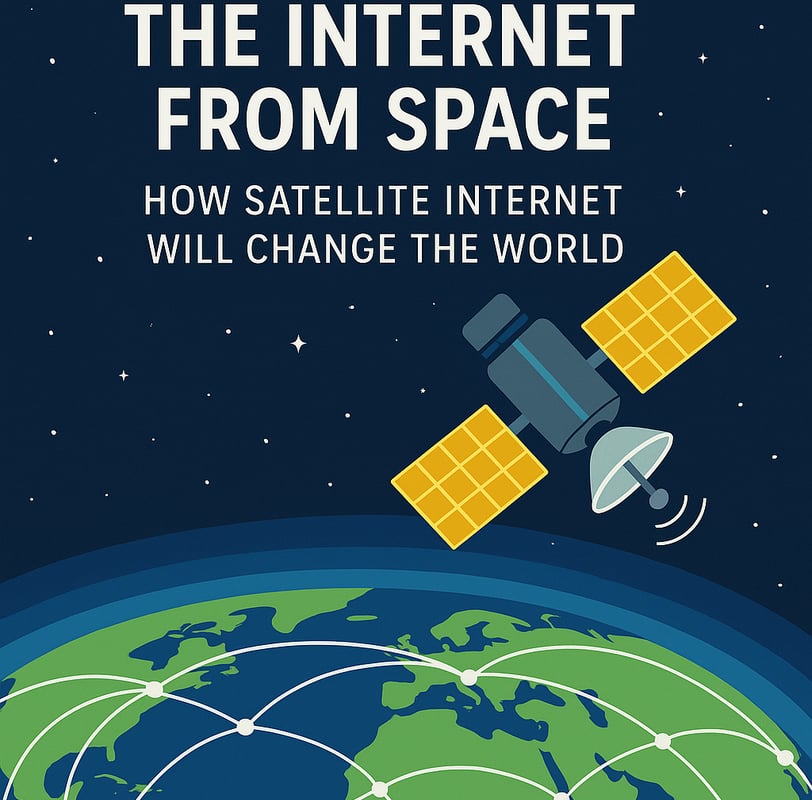The Internet from Space: How Satellite Internet Will Change the World
Discover how satellite internet is changing the way we connect. From bringing high-speed internet to remote areas to helping during disasters, this space-powered technology is shaping the future of global communication.
TECH NEWS & UPDATES


In the 21st century, the internet has become as essential as electricity or clean water. But while many of us enjoy fast, reliable access, over 2.6 billion people around the world still live without it. That’s about one-third of the global population, cut off from the opportunities of the digital age.
This is where satellite internet a futuristic yet fast-developing technology comes into play. With space-based satellites now delivering broadband across remote and rural regions, we’re witnessing the start of a revolution. One that could make the internet truly global, for the first time in history.
What Is Satellite Internet?
Satellite internet is a type of wireless connection that uses orbiting satellites to beam internet signals directly to user terminals on Earth. Unlike traditional internet—which relies on underground fiber cables or cell towers—satellite internet doesn't need a lot of ground infrastructure.
Instead, it operates from space, with companies deploying fleets of satellites known as constellations. These networks orbit the Earth at high speeds and low altitudes (usually in low Earth orbit, or LEO), allowing for faster speeds and lower delay than traditional satellites, which were placed farther away in geostationary orbits.
Today, big tech players like SpaceX (Starlink), Amazon (Project Kuiper), and OneWeb are leading the charge. Together, they’re launching thousands of satellites with one goal: to bring high-speed internet access to every corner of the Earth.
Why Satellite Internet Matters
1. Connecting the Unconnected
One of the most powerful promises of this space-based technology is global coverage. Remote villages in Africa, isolated islands in the Pacific, Arctic research stations, and rural farms in the U.S.—these are the places that current infrastructure doesn’t reach.
Satellite internet bypasses the need to dig up roads or install towers. With just a satellite dish and clear sky, people can connect to the web and access everything from education and healthcare to e-commerce and remote jobs.
2. Resilience in Emergencies
In natural disasters like earthquakes, floods, or hurricanes, ground infrastructure often gets destroyed. Internet blackouts slow down rescue operations, disrupt communication, and delay relief.
Satellite internet, on the other hand, can be quickly deployed in disaster zones. Organizations like the United Nations, Red Cross, and FEMA are already using it to coordinate aid, connect field hospitals, and restore communication when lives are at risk.
3. A Future Platform for Innovation
With billions of new users potentially coming online, we’re looking at a massive expansion of the digital economy. More people online means:
New markets for e-learning, mobile banking, and digital entrepreneurship
More data for smart agriculture, telemedicine, and supply chain logistics
A larger talent pool for remote-first companies across the globe
In this sense, satellite internet is not just about faster Netflix—it’s about creating a fairer, more connected future where everyone can participate in the global economy.
How Does It Work?
Modern satellite internet systems use low Earth orbit satellites flying at around 500–2,000 km above the Earth’s surface. Each satellite connects to ground stations (called gateways) and beams data to user terminals, usually small flat antennas installed at homes or businesses.
The biggest advantage of LEO is latency—the time it takes for data to travel back and forth. While traditional satellites had delays of 600ms or more, LEO networks can get it down to 20–40ms—fast enough for video calls, gaming, and streaming.
Challenges to Overcome
While the promise is exciting, satellite internet still faces hurdles:
High costs: Equipment and subscription fees are still too expensive for many low-income regions.
Space debris: Thousands of new satellites raise concerns about orbital congestion and the risk of collisions.
Regulatory battles: Who controls the skies? International laws for frequency use, satellite tracking, and data privacy are still being developed.
Environmental concerns: Rocket launches and satellite re-entry may contribute to space and atmospheric pollution.
Despite these issues, companies and governments are working to solve them—through better satellite design, shared infrastructure, and more accessible pricing.
The Bigger Picture: Why Space Tech Matters
For most of history, space was the realm of astronauts and scientists. But now, thanks to technological innovation, it’s becoming a part of everyday life. From GPS to weather forecasting and now internet access, the tools we rely on are increasingly orbiting above us.
Satellite internet represents more than just faster speeds. It’s a symbol of how technology and space are blending to create a more inclusive digital world. As these constellations grow, so will opportunities for education, innovation, and connection—especially for those who have been left out until now.
Final Thoughts: The Future Is Above Us
The internet from space isn’t science fiction anymore—it’s launching right now. With thousands of satellites already active and many more on the way, we’re looking at a future where location no longer limits access to knowledge or opportunity.
In the coming years, as technology improves and prices drop, satellite internet could help erase the digital divide, power remote economies, and even make humanity better prepared for the challenges of climate change, migration, and disaster response.
The future of the internet is bright, global, and floating in space.
